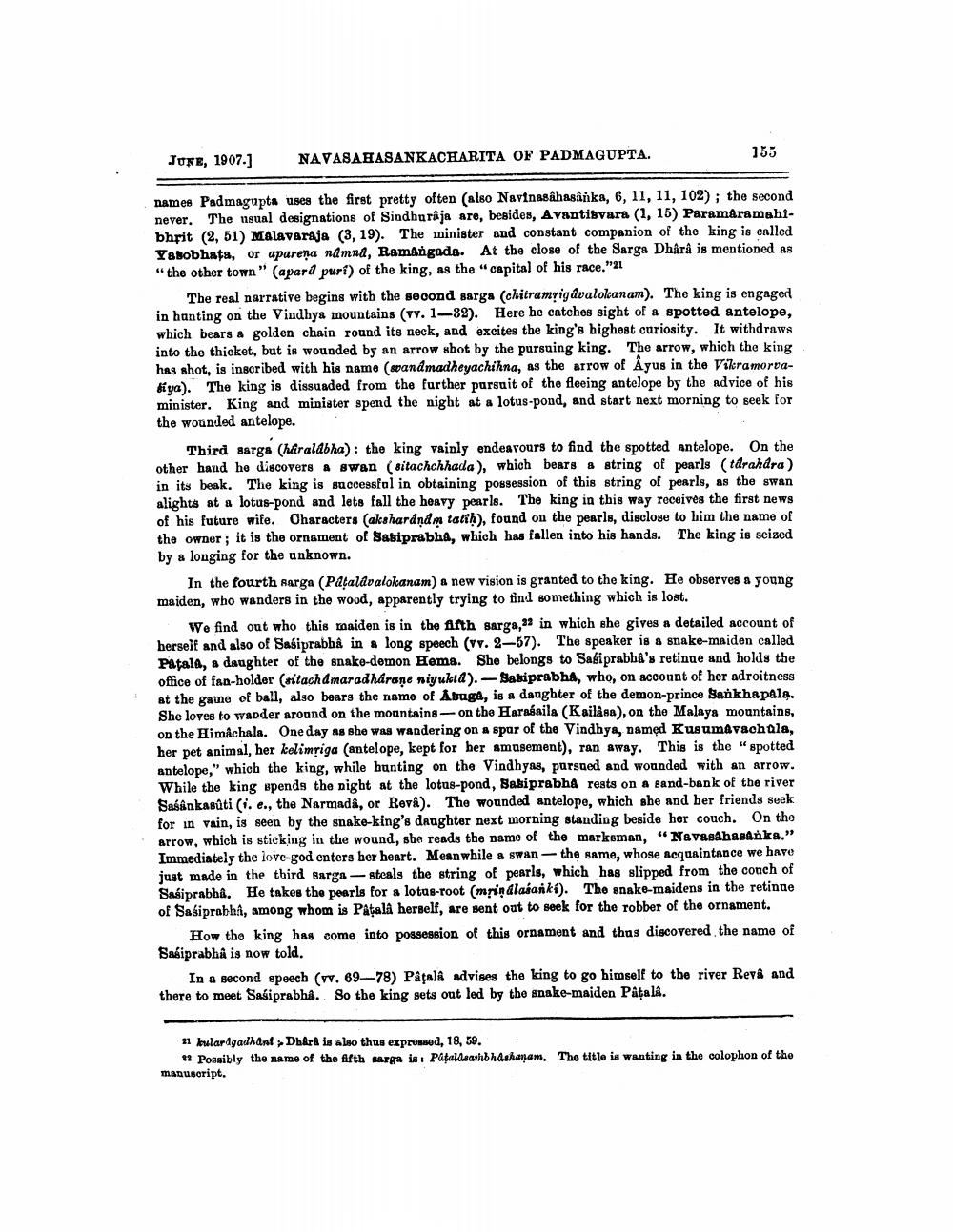________________
155
JUNE, 1907.]
NAVASAHASANKACHARITA OF PADMAGUPTA.
never.
names Padmagupta uses the first pretty often (also Navinasâhasanka, 6, 11, 11, 102); the second The usual designations of Sindhurâja are, besides, Avantisvara (1, 15) Paramaramahibhrit (2, 51) Malavaraja (3, 19). The minister and constant companion of the king is called Yasobhata, or aparena namna, Ramangada. At the close of the Sarga Dhârâ is mentioned as "the other town" (apard puri) of the king, as the "capital of his race."21
The real narrative begins with the second sarga (chitramṛigavalokanam). The king is engaged in hunting on the Vindhya mountains (vv. 1-82). Here he catches sight of a spotted antelope, which bears a golden chain round its neck, and excites the king's highest curiosity. It withdraws into the thicket, but is wounded by an arrow shot by the pursuing king. The arrow, which the king has shot, is inscribed with his name (svandmadheyachihna, as the arrow of Ayus in the Vikramorvasiya). The king is dissuaded from the further pursuit of the fleeing antelope by the advice of his minister. King and minister spend the night at a lotus-pond, and start next morning to seek for the wounded antelope.
Third sarga (haralabha): the king vainly endeavours to find the spotted antelope. On the other hand he discovers a swan (sitachchhada), which bears a string of pearls (tarahara) in its beak. The king is successful in obtaining possession of this string of pearls, as the swan alights at a lotus-pond and lets fall the heavy pearls. The king in this way receives the first news of his future wife. Characters (akshardnám tattḥ), found on the pearls, disclose to him the name of the owner; it is the ornament of Sasiprabha, which has fallen into his hands. The king is seized by a longing for the unknown.
In the fourth sarga (Patalavalokanam) a new vision is granted to the king. He observes a young maiden, who wanders in the wood, apparently trying to find something which is lost.
We find out who this maiden is in the fifth sarga, 22 in which she gives a detailed account of herself and also of Sasiprabha in a long speech (vv. 2-57). The speaker is a snake-maiden called Patala, a daughter of the snake-demon Hema. She belongs to Sasiprabhâ's retinue and holds the office of fan-holder (sitachámaradhárane niyukta).- Basiprabha, who, on account of her adroitness at the game of ball, also bears the name of Asuga, is a daughter of the demon-prince Sankhapala. She loves to wander around on the mountains- on the Harasaila (Kailasa), on the Malaya mountains, on the Himachala. One day as she was wandering on a spur of the Vindhya, named Kusumavachula, her pet animal, her kelimriga (antelope, kept for her amusement), ran away. This is the "spotted antelope," which the king, while hunting on the Vindhyas, pursued and wounded with an arrow.. While the king spends the night at the lotus-pond, Basiprabha rests on a sand-bank of the river Sasankasûti (i. e., the Narmadâ, or Revâ). The wounded antelope, which she and her friends seek for in vain, is seen by the snake-king's daughter next morning standing beside her couch. On the arrow, which is sticking in the wound, she reads the name of the marksman, "Navasahasanka." Immediately the love-god enters her heart. Meanwhile a swan-1 the same, whose acquaintance we have just made in the third sarga-steals the string of pearls, which has slipped from the couch of Sasiprabhâ. He takes the pearls for a lotus-root (mrinalasanki). The snake-maidens in the retinue of Sasiprabha, among whom is Pâțalâ herself, are sent out to seek for the robber of the ornament.
How the king has come into possession of this ornament and thus discovered the name of Sasiprabha is now told.
In a second speech (vv. 69-78) Pâțalâ advises the king to go himself to the river Revâ and there to meet Sasiprabha. So the king sets out led by the snake-maiden Pâțalâ.
21 kularâgadhani Dhårå is also thus expressed, 18, 59.
12 Possibly the name of the fifth sarga is: Patalasashbhashanam. The title is wanting in the colophon of the manuscript.




